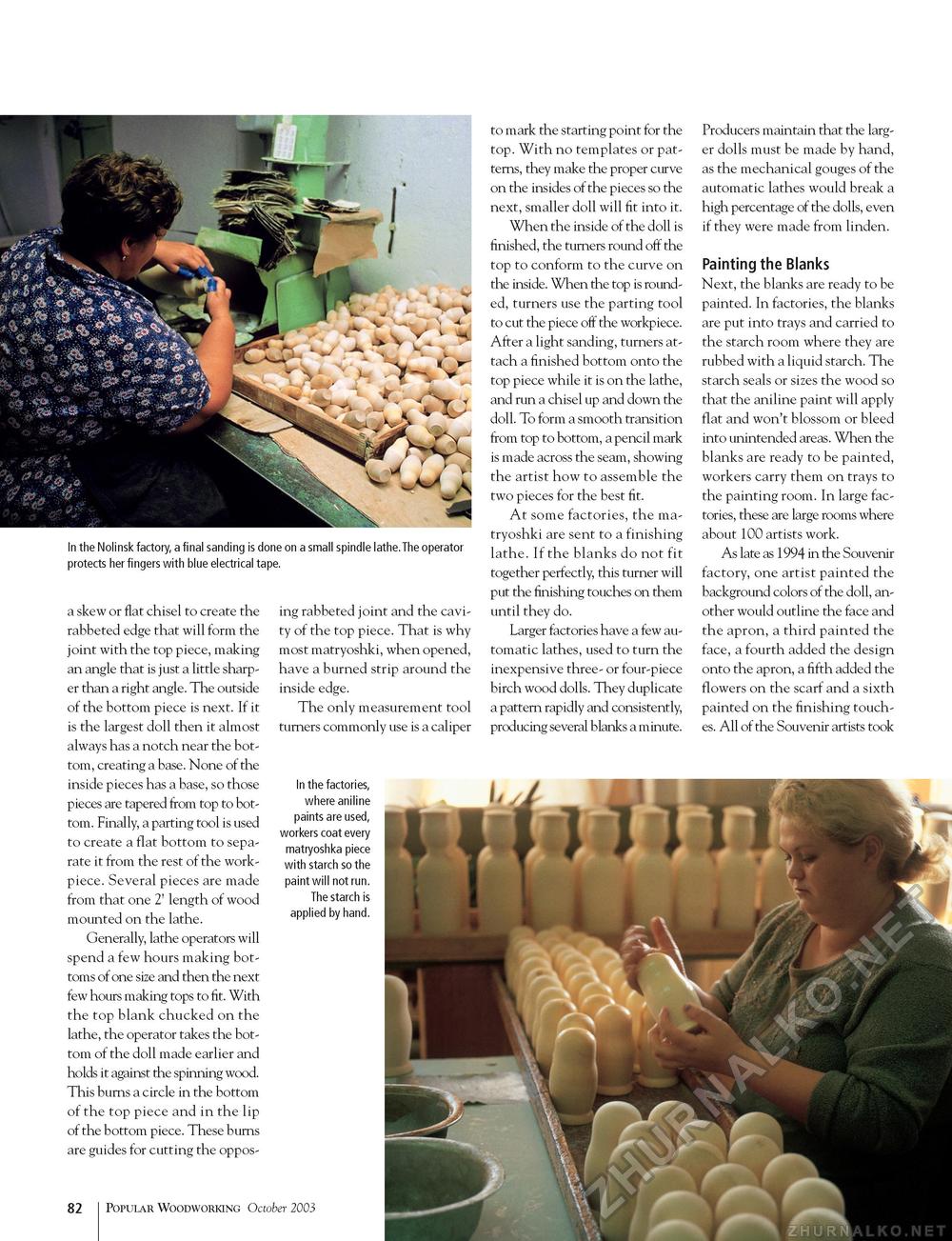Popular Woodworking 2003-10 № 136, страница 82
In the Nolinsk factory, a final sanding is done on a small spindle lathe. The operator protects her fingers with blue electrical tape. a skew or flat chisel to create the rabbeted edge that will form the joint with the top piece, making an angle that is just a little sharper than a right angle. The outside of the bottom piece is next. If it is the largest doll then it almost always has a notch near the bottom, creating a base. None of the inside pieces has a base, so those pieces are tapered from top to bottom. Finally, a parting tool is used to create a flat bottom to separate it from the rest of the work-piece. Several pieces are made from that one 2' length of wood mounted on the lathe. Generally, lathe operators will spend a few hours making bottoms of one size and then the next few hours making tops to fit. With the top blank chucked on the lathe, the operator takes the bottom of the doll made earlier and holds it against the spinning wood. This burns a circle in the bottom of the top piece and in the lip of the bottom piece. These burns are guides for cutting the oppos ing rabbeted joint and the cavity of the top piece. That is why most matryoshki, when opened, have a burned strip around the inside edge. The only measurement tool turners commonly use is a caliper In the factories, where aniline paints are used, workers coat every matryoshka piece with starch so the paint will not run. The starch is applied by hand. to mark the starting point for the top. With no templates or patterns, they make the proper curve on the insides of the pieces so the next, smaller doll will fit into it. When the inside of the doll is finished, the turners round off the top to conform to the curve on the inside. When the top is rounded, turners use the parting tool to cut the piece off the workpiece. After a light sanding, turners attach a finished bottom onto the top piece while it is on the lathe, and run a chisel up and down the doll. To form a smooth transition from top to bottom, a pencil mark is made across the seam, showing the artist how to assemble the two pieces for the best fit. At some factories, the ma-tryoshki are sent to a finishing lathe. If the blanks do not fit together perfectly, this turner will put the finishing touches on them until they do. Larger factories have a few automatic lathes, used to turn the inexpensive three- or four-piece birch wood dolls. They duplicate a pattern rapidly and consistently, producing several blanks a minute. Producers maintain that the larger dolls must be made by hand, as the mechanical gouges of the automatic lathes would break a high percentage of the dolls, even if they were made from linden. Painting the Blanks Next, the blanks are ready to be painted. In factories, the blanks are put into trays and carried to the starch room where they are rubbed with a liquid starch. The starch seals or sizes the wood so that the aniline paint will apply flat and won't blossom or bleed into unintended areas. When the blanks are ready to be painted, workers carry them on trays to the painting room. In large factories, these are large rooms where about 100 artists work. As late as 1994 in the Souvenir factory, one artist painted the background colors of the doll, another would outline the face and the apron, a third painted the face, a fourth added the design onto the apron, a fifth added the flowers on the scarf and a sixth painted on the finishing touches. All of the Souvenir artists took 82 Popular Woodworking October 2003 |








